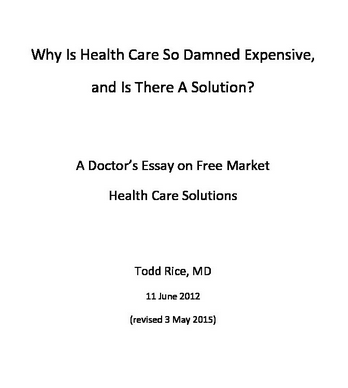Yesterday, I was talking to a colleague about the ongoing deterioration of health care economics – a common topic among us doctors – and referenced Dr. William C. Waters’ book, Two Days That Ruined Your Health Care. I remembered having written an essay about this topic a decade ago, and I post it here for posterity and the interested. Of course, systems and finances have deteriorated significantly since the 2012 writing, but the fundamentals of economics and legislation persist.
As a physician, still relatively new to private practice (about 6 years), I have found my greatest challenge has not been in the practice of medicine, in providing patients with safe anesthetic experiences throughout their surgeries, or in keeping up with the pace of medical advancements, but in working my way through non-medical bureaucracies and their endless streams of complicating consequences. Some of those bureaucracies include the third party payors that “reimburse” doctors for their services. These payors may be private insurance companies, like Aetna, Blue Cross and United, for example. Increasingly, payors are government entitities: Medicare, Medicaid, State Children’s Health Insurance Programs (CHIPS), Tricare (for the present and former military personnel), etc. In addition to the dictates of the payment intermediaries, there are innumerable layers of rules, regulations and advisories heaped upon the medical community primarily by government-related agencies such as the federal Center for Medicare and Medicaid Services (CMS), Health and Human Services (HHS), the Drug Enforcement Agency (DEA ), Joint Commission on the Accreditation of Healthcare Organizations (JCAHO), the state Department of Health, and the state Department of Public Safety, to name those that quickly come to mind.
As a result of all of this interference between a doctor and the patient, and one of the surprising realizations for which I received no real preparation neither in medical school nor in my four year anesthesiology residency, is that I have no idea how much you pay me when I keep you asleep and alive for your appendectomy, or your elective knee replacement, or the emergent 2:00 AM ruptured abdominal aneurysm repair. I don’t know how much I will be paid for my service to you. I couldn’t tell you how much you would owe to me or to the hospital or to the surgeon. They probably don’t know either, at least not readily. Sure, I have a rough idea of what I will average in income over the course of a month, but what you personally will pay is a mystery to both of us. How could that possibly be? Is there another industry in which costs are hidden from both the provider and the recipient of the service, in which some non-present third party that lies outside of the interaction governs its financing and influences its specifics? How did this system come to exist?
It has taken a good deal of investigation, personal experience and not an inconsequential degree of angst, to begin to piece together how medical payments and economics work. While it is still beyond my complete comprehension, I would like to share some of the points that I’ve learned. I invite others to follow the references that I provide. I hope they can verify for themselves how this perverse system developed and identify the best solutions. Certainly, just as in politics or foreign relations, we cannot move to repair a situation without first understanding its history. Like mine, your view will be influenced by your personal ideologies, moralities and politics, e.g. your concept of individual rights, of the appropriate role of government in our lives, of your impression of man’s ability for self-sufficiency versus a need for significant external assistance, etc.
For myself, one of the most significant insights into the history of medical financing was gained when I came across a short book by William C. Waters, III, MD entitled 2 Days That Ruined Your Health Care (And How You Can Provide the Cure). I highly recommend the book to any interested in the topic. You can buy a cheap, used one at amazon.com.
(Click to continue reading the .pdf file. It’s 9 pages, so grab a snack.)

